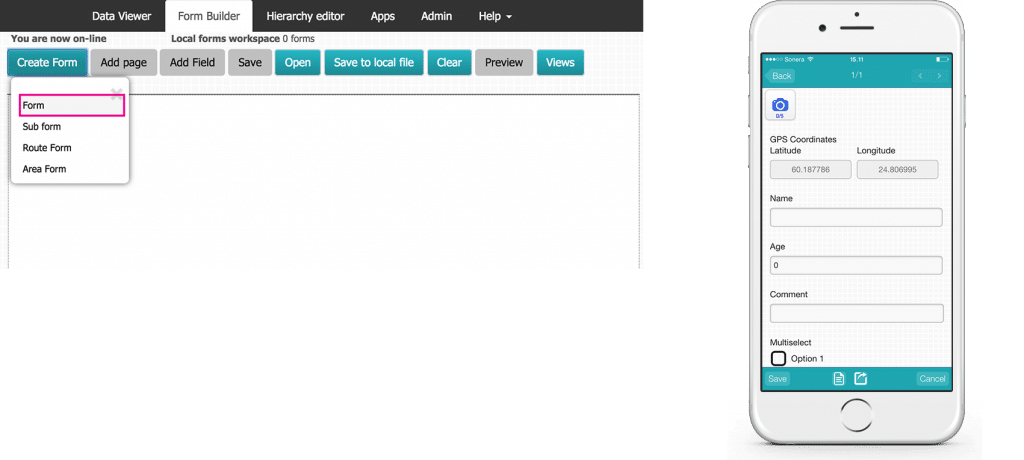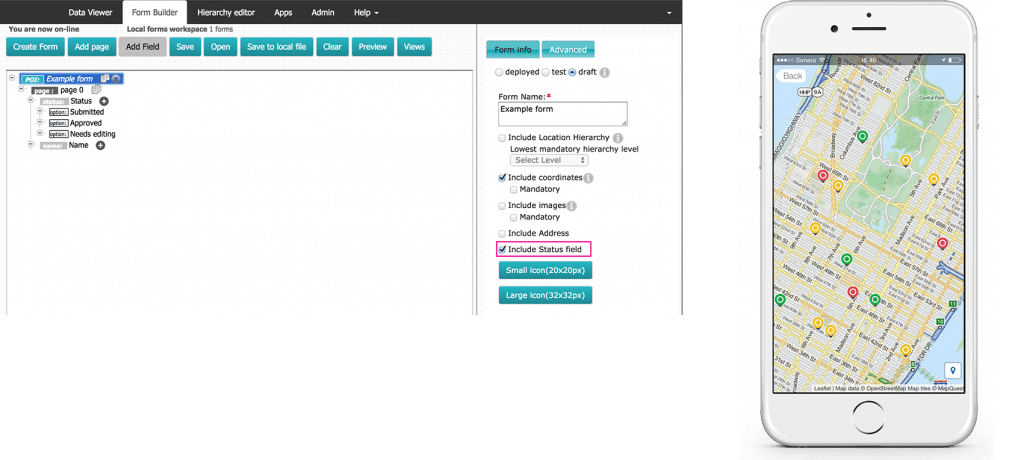
12 types of Mobile Forms for Field Reporting
Mobile forms used in field reporting can include various degrees of advancement. We classified these degrees to reflect the requirements and purposes for collecting data with mobile devices.
The simplest category of forms are forms that are a list of questions with answers, the questions represent some attribute of the object of interest e.g., name, age, comment etc. and the answers are then the values of those attributes. The main benefit of these types of forms is that only a few field types are needed e.g., text, number which makes them easy and fast to use.
What we like to call basic mobile forms, are formed with the additions of single- and multi-choice fields. Typically extended with the ability to attach images to the form.
POI forms are basic forms extended with longitude and latitude information, typically obtained using the GPS feature available on the mobile device. Mobile Forms for Field Reporting is currently the most common category for mobile forms.
Choose the Form type you want to create. Point-of-interest forms include GPS coordinates, basic mobile forms often have images and multi-choice fields.

Route and area forms are similar to POI forms, except that instead of recording a single long-lat, a sequence of such pairs is recorded to form a line that marks either a route or area boundaries. The only difference between route and area forms is that the area forms have an additional line between the end and starting points of the recorded line, the additional line ties the tracked lines together and forms an area.
These forms are the same as basic forms, but in addition, a user can attach audio and video files to the form.
When advancing to more complex data collection one often wants to have questions conditional on previous answers. These can be organized as sub-questions. The sub-questions can be organized as multilevel hierarchies if there are sub-questions under sub-questions.
With a scripting language, one can define conditional questions based on logical conditions calculated from values of previous answers. One can also then calculate values for fields, based on values of previous answers, e.g., total answer scores or total cost of selected items. If the script language is dynamic and advanced enough one can define forms to include the expertise of the organizations, i.e. become expert systems. These open up totally new uses of mobile forms as guides to field workers.
Dynamic forms mean forms that have a flexible structure. A flexible structure can be achieved by having tables embedded in the forms, with the ability to add rows to the table during use. This has the obvious benefit of being able to collect a lot of data in a compact way. A larger screen of a tablet is often preferred for data collection with dynamic forms. Another more flexible way of creating dynamic forms is to have subforms. Subforms enable more questions and for example A/V files can be attached, script logic etc. to be combined with a dynamic form structure, leading to the ability to create very advanced and complex forms. More complex forms benefit from more powerful devices.
When collecting more data e.g., covering a whole country, one might want to organize the data by district, county, sales region, or some other relevant grouping such as habitat or harbour area. Therefore, it is important to have the ability to define multilevel location hierarchies and to link each collected data point to a specific element in the hierarchy. This feature should obviously be available irrespective of what kind of category the form has otherwise.
There are also forms with automated address determination. It is possible to either determine the geolocation automatically based on address information or conversely determine the address automatically based on the geolocation. The former case is useful if one has an existing place from where data needs to be collected e.g., stores. The latter is useful for instance when new data is collected in the field and automatically classified e.g., according to postal codes. An enhancement to the latter case is that one addition links the postal codes to the defined location hierarchy, thus automating the classification of the collected data.
The most advanced setup is when forms are not only dynamic but have interrelations, meaning that when collecting data with one form, one gets data from another form as background data to avoid having to fill in data that has been already collected. An example of such a case is when collecting class attendance data in schools and having already existing student-specific forms collected. One way to use this type of feature is to have the concept of a lookup value field that can refer to other forms. With this lookup value field, one can then select from an available list of data points of a certain form type and include the data from the selected adaption in the existing form.
In international organizations often the same data needs to be collected in multiple countries, or even in the same country where several languages are used. This requires that the same form can be viewed using different languages. Multilanguage forms are essential so that overall reporting can include all the relevant data irrespective of in which language it has been collected.
Many organizations collecting important business data want to have a systematic QA process for approving the collected data. Then one needs to have the concept of status of forms. The types of status may vary but typically there are five:
1. Draft, which is data still being in the mobile app and more data needs to be collected,
2. Saved, data is complete in the app, but not yet submitted to the server
3. Submitted, the data is submitted to the server for review and approval
4. Needs editing, the data has been reviewed and requires some corrections
5. Approved.
An efficient way to visualize the data is to present the status with colours, yellow for submitted, green for approved, red for needs editing.

There’s plenty of development happening every day. We will be releasing new features in mobile forms soon so stay tuned.
Register here to build your first Mobile forms with the Poimapper form builder in minutes.
If you have any questions, please don’t hesitate to contact us.
You can read more about like this, click here!